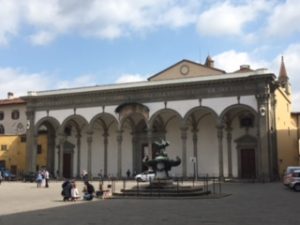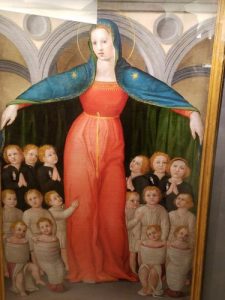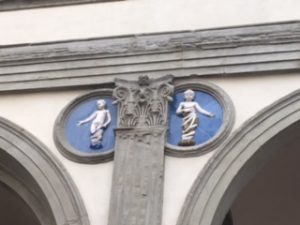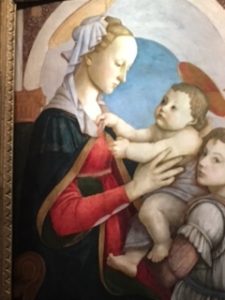 This week I celebrate two spring holy holidays in one city that embraces spirituality, civility, and culture: Florence, Italy. Today, I had the special opportunity to tour Ospedale degli Innocenti: the Hospital of the Innocents. The hospital is now an institute for studying the culture and economics of children, and a museum telling a unique story of Florentine babies born in the early 15th century, spanning our contemporary era. The founding and root history of this beautiful place has lessons to teach us even today.
This week I celebrate two spring holy holidays in one city that embraces spirituality, civility, and culture: Florence, Italy. Today, I had the special opportunity to tour Ospedale degli Innocenti: the Hospital of the Innocents. The hospital is now an institute for studying the culture and economics of children, and a museum telling a unique story of Florentine babies born in the early 15th century, spanning our contemporary era. The founding and root history of this beautiful place has lessons to teach us even today.
It is key to realize, first, that Florentine humanism exalted the ideal virtues of the child and role in society during the Renaissance era (the long period from the 14th century into the 16th century). In that context, the Hospital of the Innocents officially opened in 1445, dedicated to be a benevolent institution to take in children — the “innocents.” As the “ideal city” that was to be Florence was developing, institutions were created to support such idealism. In this case, the Ospedale, or hospital, was a place where abandoned, poor, and sick children could be brought back to health and lead productive lives. The humanist’s belief was that it was a citizen’s responsibility to be involved in civic issues: the concept of “confraternita.”
 One representative of this idealistic age was Brunelleschi, the architect, who designed the hospital which over the past 600 years has retained the major aspects of Renaissance architecture. Nine arches with terra cotta sculptures of swaddled babies, by Della Robbia, mark the facade of this long structure which sits on a large plaza, the Piazza S.S. Annunziata.
One representative of this idealistic age was Brunelleschi, the architect, who designed the hospital which over the past 600 years has retained the major aspects of Renaissance architecture. Nine arches with terra cotta sculptures of swaddled babies, by Della Robbia, mark the facade of this long structure which sits on a large plaza, the Piazza S.S. Annunziata.
 The first baby taken in was a girl. “The little girls of the period were looked at merely as mouths to feed and as economically useless,” according to the officially history of the Ospedale, so many girls were given up for financial reasons. Foundling hospitals at the time had a majority of girls as residents. Newborn inmates were abandoned nude or covered with rags. The children were then wrapped in swaddling clothes made of strips of linen or wool. Note the Della Robbia sculptured babies all swaddled, with arms left free. This image has become the icon for the organization to this day.
The first baby taken in was a girl. “The little girls of the period were looked at merely as mouths to feed and as economically useless,” according to the officially history of the Ospedale, so many girls were given up for financial reasons. Foundling hospitals at the time had a majority of girls as residents. Newborn inmates were abandoned nude or covered with rags. The children were then wrapped in swaddling clothes made of strips of linen or wool. Note the Della Robbia sculptured babies all swaddled, with arms left free. This image has become the icon for the organization to this day.
Parents abandoned babies at this hospital, which over time educated the boys in reading, writing and grammar through teachers. Some grew up to become priests, and some so-called “men of worth.”
 The girls were differently treated in this era: literacy was a challenge, and girls generally learned the “domestic arts” working in upper-class families. Some of the luckier girls were taught knowledge in families that embraced them as daughters and these girls grew to earn dowries that could be eventually used for marriage.
The girls were differently treated in this era: literacy was a challenge, and girls generally learned the “domestic arts” working in upper-class families. Some of the luckier girls were taught knowledge in families that embraced them as daughters and these girls grew to earn dowries that could be eventually used for marriage.
The Ospedale was managed by hospital administrators, called spedalinghi (like rectors or priors), who worked with financial directors, legal advisors, and guild patrons. In particular, the Silk Guild of Florence was most closely allied to the Ospedale degli Innocenti. As such, a silk winding factory was built close to the hospital and girls could work there.
Today, the institute is involved in children’s causes and education on a global basis with UNICEF, and locally supports social service programs.
 Health Populi’s Hot Points: Visiting the Ospedale this week of spiritual renewal is coupled with (some) Americans’ dissatisfaction back across the Pond. Such was my own context and lens through which I took in the history and lessons of this magnificent architectural and social treasure of the Ospedale. With my dual professional hats of public health and economics, the idea of “confraternita” is not lost on me and the work I do at the intersection of people, health, and technology. All of my work centers on the concept of the Triple Aim, as conceived by Dr. Donald Berwick: to support population (and public) health; to make healthcare better (processes and workflows, and the patient and professional’s experience); and, to lower health care costs per person.
Health Populi’s Hot Points: Visiting the Ospedale this week of spiritual renewal is coupled with (some) Americans’ dissatisfaction back across the Pond. Such was my own context and lens through which I took in the history and lessons of this magnificent architectural and social treasure of the Ospedale. With my dual professional hats of public health and economics, the idea of “confraternita” is not lost on me and the work I do at the intersection of people, health, and technology. All of my work centers on the concept of the Triple Aim, as conceived by Dr. Donald Berwick: to support population (and public) health; to make healthcare better (processes and workflows, and the patient and professional’s experience); and, to lower health care costs per person.
What the Ospedale was committed to do was marry a civic mission — shelter and care for abandoned and sick kids, heal them, and prepare them for their world — within the context of the economic realities of the time. But the humanistic vision of “confraternita” always underpinned the institution over hundreds of years, even as cultural nuances and economic scenarios altered.
 It may surprise you to know that The American Academy of Pediatrics adopted the Della Robbia swaddled baby in its own organization’s branding, as shown in the diagram. Children in the U.S., and their parents, are fortunate to have physicians who understand that investing in kids’ health means investing in adults’ health, too.
It may surprise you to know that The American Academy of Pediatrics adopted the Della Robbia swaddled baby in its own organization’s branding, as shown in the diagram. Children in the U.S., and their parents, are fortunate to have physicians who understand that investing in kids’ health means investing in adults’ health, too.
In the United States, we have an opportunity to embrace a health/care culture with such a vision. It would take a commitment among health citizens — that is, the people of America — to want this and will this to happen. As we approach the 2017 holy spring holiday season, as we share stories about liberating slaves, empowering people, and renewing our lives and spirits, we should keep this ideal in mind. History is a wonderful teacher. Embracing our individual health citizenship is the first step toward becoming a health citizenry, at scale.
History of art note: The works of art shown here are just two among dozens of masterworks that are part of the Museo degli Innocenti. These works had been given to the Ospedale during the Renaissance era by the artists and patrons of the institution, and represent a gem of a collection to visit when you are in Florence. The two shown here are (top) Madonna degli Innocenti by Michelino; and (bottom) Madonna col Bambino by Botticelli. The Michelino Madonna is especially intriguing because it shows Mary sheltering children other than her baby, Jesus. Here, she is protecting the swaddled children of the Ospedale. It is a very moving and distinctive image.





 Thank you, Jared Johnson, for including me on the list of the
Thank you, Jared Johnson, for including me on the list of the  I am so grateful to Tom Lawry for asking me to pen the foreword for his book, Health Care Nation,
I am so grateful to Tom Lawry for asking me to pen the foreword for his book, Health Care Nation,  Thanks to Feedspot for naming this blog, Health Populi, as a
Thanks to Feedspot for naming this blog, Health Populi, as a